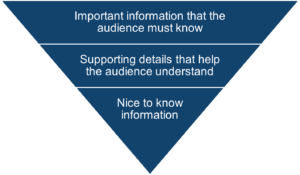Writing about data
Policy details
| Metadata item | Details |
|---|---|
| Publication date: | 3 April 2025 |
| Owner: | GSS Presentation Champions Network |
| Approver: | Head of Energy Statistics and GSS Head of Profession at DESNZ |
| Who this is for: | Everyone |
| Type: | Guidance |
| Contact: | Analysis.Function@ons.gov.uk |
Introduction
This guidance outlines several important points to remember when writing about data. It provides a concise summary of existing guidance to help you communicate your analysis in a clear and engaging way. Links to further guidance are included throughout which provide more detail if needed.
This guidance is relevant for analysts communicating about data and analysis, for example in statistical publications. It builds on the archived writing about statistics guidance.
Analysis that is communicated well should:
- be tailored to the audience
- use plain language
- concentrate on the important points
- put the data into context
- have a logical and organised structure
- be transparent about the strengths, limitations, and any uncertainty
All written content should be accessible to meet the needs of users. See the Analysis Function guidance on making analytical publications accessible for more information.
.
Be tailored to the audience
You should:
- understand who your audience is and what they are interested in
- make sure your tone and language meet their needs
- think about what questions they will ask, and answer these in your writing
Further guidance:
- Office for National Statistics (ONS) service manual on writing for users
- ONS Engagement Hub top tips for user engagement
- Office for Statistics Regulation (OSR) ‘Statistics in Personal Decision-Making‘ — this guidance contains advice for writing for a non-expert audience, such as the general public
.
Use plain language
You should:
- assume the audience does not have technical knowledge
- explain any technical terms
- write out any abbreviations the first time they are used
- consider shortening or removing any words where you can
- sentences should be up to or around 25 words
Example:
- Before: “Gross weekly pay in the bottom income decile was below £276 for full-time employees.”
- After: “One in ten full-time employees earned less than £276 per week.”
Further guidance:
- Government Digital Service (GDS) guidance on how to write well for your audience
- GDS list of words to avoid and alternative options
- Guidance from the Plain English Campaign on writing clearly
.
Concentrate on the important points
You should:
- only include information relevant to the audience
- be specific about the point you are making
- assume the audience does not have much time
- limit each paragraph to one idea or trend
- your audience should be able to read the first sentence of each paragraph and be able to understand the main points of the analysis
- write the most important information on the top left of the page, as readers often scan in an F-shaped pattern
Example:
- Before: “The implementation of this new policy will result in a significant reduction in the time required to process applications, which is estimated to decrease by 32.14% and thereby overall efficiency and customer satisfaction will be enhanced.”
- After: “This new policy will speed up applications, improve efficiency, and increase customer satisfaction. Processing time is estimated to fall by about one-third (32%).”
Further guidance:
- Hemingway Editor shows which parts of your writing are too long and complex (do not input sensitive information or data)
- Research shows that people often read across the top of the page and then down the left-hand side
.
Put the data into context
You should:
- explain the overall trend and highlight specific areas of interest
- help the audience understand the importance of the data
- for example, is a 2% rise unusual compared to previous years, other countries, or the policy target?
- make comparisons between groups to show important differences
- highlight any implications of the data
Example:
- “There were 787,000 suspensions in the 2022/23 academic year. This is an increase from the previous year, when 578,300 suspensions occurred, and the highest recorded annual number of suspensions.” – Suspensions and permanent exclusions in England, Academic year 2022/23, Department for Education
- “Since 1970, [bird species] indicators have declined by 16% in both the UK and England. Both indicators declined most between the late 1970s and the early 1990s, driven mostly by steep declines in woodland and farmland birds. Those two indicators then remained relatively stable or showed shallow declines until the mid 2010s, before in recent years showing a slightly accelerated downward trend.” – Wild bird populations in the UK and England, 1970 to 2023, Department for Environment, Food & Rural Affairs
Further guidance:
- Government Statistical Service (GSS) guidance on writing about statistics
- Government Data Quality Hub (DQHub) guidance on communicating data quality and communicating the impact of COVID-19
.
Have a logical and organised structure
You should:
- use the inverted pyramid – the most important information should be first and everything else arranged from most to least important
- make sure that charts or tables are explained and integrated with the text
- have short and descriptive headings so the audience can find the topic that they are interested in
- avoid generic titles like ‘abstract’ or ‘executive summary’ as they do not tell the audience what is in that section
Figure 1: The inverted pyramid of information
.

Figure 1 shows the ideal structure of information in any writing. Important information that the audience must know should come first, followed by supporting details that help the audience understand, and followed lastly by nice to know information.
Further guidance:
- Office for National Statistics (ONS) service manual on structuring content
- Analysis Function guidance on designing charts
.
Be transparent about the strengths, limitations, and any uncertainty
You should:
- include information to help your audience confidently use the data
- be clear about the quality of information, the methodology used, and any limitations
- explain what any uncertainties are, why they exist, and what their effect on the data is
Example:
- This analysis of adult smoking habits in the UK by the Office for National Statistics (ONS) clearly states up front what you can and cannot do with the data
Further guidance:
- Government Data Quality Hub (DQHub) guidance on communicating quality, uncertainty and change
- Uncertainty Toolkit for Analysts in Government guidance on presenting and communicating uncertainty
- Office for Statistics Regulation (OSR) report on presenting uncertainty
